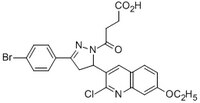530535 Sigma-AldrichRPA Inhibitor, TDRL-505 - CAS 1785760-75-9 - Calbiochem
A cell-permeable compound that targets human Replication Protein A (RPA) and inhibits its DNA-binding activity (IC₅₀= 12.9 µM).
More>> A cell-permeable compound that targets human Replication Protein A (RPA) and inhibits its DNA-binding activity (IC₅₀= 12.9 µM). Less<<Synonymes: Replication Protein A Inhibitor, Pot1 Inhibitor, Protection of Telemeres Protein 1 Inhibitor, TDRL505
Produits recommandés
Aperçu
| Replacement Information |
|---|
Tableau de caractéristiques principal
| CAS # | Empirical Formula |
|---|---|
| 1785760-75-9 | C₂₄H₂₁BrClN₃O₄ |
Prix & Disponibilité
| Référence | Disponibilité | Conditionnement | Qté | Prix | Quantité | |
|---|---|---|---|---|---|---|
| 5.30535.0001 |
|
Flacon en verre | 25 mg |
|
— |
| Description | |
|---|---|
| Overview | A cell-permeable quinolinyl-dihydropyrazolyl-oxobutanoic acid compound that is shown to target human Replication Protein A (RPA) via primarily the oligosaccharide/oligonucleotide-binding (OB) folds of DNA-bonding domains A & B (DBD-A/B) in the p70 subunit, effectively inhibiting its DNA-binding activity as well as that of Schizosaccharomyces pombe telemere end-binding protein Pot1 (IC50= 12.9 µM and 15.7 µM, respectively), but not Xeroderma pigmentosum group A protein (XPA) involved in the nucleotide excision repair (NER) pathway or E. coli SSB. Reported to induce cell cycle G1-arrest and decrease Annvex V-/PI- healthy cell population (by 50%; 30.8 µM for 48 h) in H460 non-small cell lung carcinoma (NSCLC) cultures with minimal cytotoxicity against freshly isolated human PBMC. Potentiates cisplatin (Cat. No. 232120) and etopside (Cat. No. 341205) cytotoxicity in H460 cultures in a synergistic manner. |
| Catalogue Number | 530535 |
| Brand Family | Calbiochem® |
| Synonyms | Replication Protein A Inhibitor, Pot1 Inhibitor, Protection of Telemeres Protein 1 Inhibitor, TDRL505 |
| References | |
|---|---|
| References | Anciano Granadillo, V.J., et al. 2010. J. Nucleic Acids 2010, 304035. Shuck, S.C., and Turchi, J.J. 2010. Cancer Res. 70, 3189. |
| Product Information | |
|---|---|
| CAS number | 1785760-75-9 |
| Form | Off-white solid |
| Hill Formula | C₂₄H₂₁BrClN₃O₄ |
| Chemical formula | C₂₄H₂₁BrClN₃O₄ |
| Reversible | Y |
| Quality Level | MQ100 |
| Applications |
|---|
| Biological Information | |
|---|---|
| Primary Target | Replication Protein A |
| Primary Target IC<sub>50</sub> | 12.9, 15.7 and 30.8 µ |
| Purity | ≥97% by HPLC |
| Physicochemical Information | |
|---|---|
| Cell permeable | Y |
| Dimensions |
|---|
| Materials Information |
|---|
| Toxicological Information |
|---|
| Safety Information according to GHS |
|---|
| Safety Information |
|---|
| Product Usage Statements |
|---|
| Packaging Information | |
|---|---|
| Packaged under inert gas | Packaged under inert gas |
| Transport Information |
|---|
| Supplemental Information |
|---|
| Specifications |
|---|
| Global Trade Item Number | |
|---|---|
| Référence | GTIN |
| 5.30535.0001 | 04055977260861 |
Documentation
RPA Inhibitor, TDRL-505 - CAS 1785760-75-9 - Calbiochem FDS
| Titre |
|---|
RPA Inhibitor, TDRL-505 - CAS 1785760-75-9 - Calbiochem Certificats d'analyse
| Titre | Numéro de lot |
|---|---|
| 530535 |
Références bibliographiques
| Aperçu de la référence bibliographique |
|---|
| Anciano Granadillo, V.J., et al. 2010. J. Nucleic Acids 2010, 304035. Shuck, S.C., and Turchi, J.J. 2010. Cancer Res. 70, 3189. |
| Fiche technique | ||||||||||||||||||||||||||||
|---|---|---|---|---|---|---|---|---|---|---|---|---|---|---|---|---|---|---|---|---|---|---|---|---|---|---|---|---|
|
Note that this data sheet is not lot-specific and is representative of the current specifications for this product. Please consult the vial label and the certificate of analysis for information on specific lots. Also note that shipping conditions may differ from storage conditions.
|













